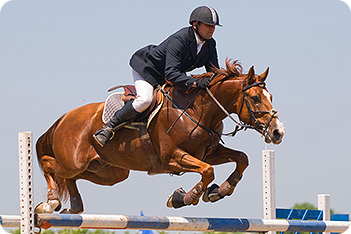
Horse Competitions
Show Jumping

Show Jumping
This is an amazing sport in which horse and rider combinations have to jump over either one or a series of obstacles. There are specific jumping competitions such as the Puissance as well as jumping for showing competitions such as Working Hunter. Depending on the competition entered will dictate the height, speed and width of the fences that are to be jumped.
History
It was all thanks to the Enclosures Act in the 18th century that first encouraged the jumping of horses to come about, this was because jumping became necessary in order to cross fields and boundary lines especially when out for a days hunting as certain fences and obstacles would have to be tackled in order to avoid having to go the long route around.
Towards the end of the 18th century in France the sport of "lepping" began. The sport of "lepping" would originally see horse and riders heading off across country and it was not long before the trend of jumping in an arena or enclosed space took hold, this was soon to became very popular especially with the spectators who could easily see the fences and watch many horses jumping them. It was towards the end of the 18th century the sport of "leaping" then appeared at the Royal Dublin show and was later brought over to England where "leaping" classes were added to many show schedules.
The first International show jumping competition in England was at Olympia in 1907 and had mainly military personal taking part. The competition rules were very different from today's with four faults being deducted for a fence knocked down by the forelegs and two faults with the hind legs and half a fault added for touching the water jump and also for touching a fence without knocking it down. By 1912 the sport of show jumping was also included in the Olympics.
Jumping Styles
To begin with riders used to jump fences with very long stirrups and a slightly backward upper body position, it was believed that this would give them a secure position, the difficulty with long stirrups comes about when the jumps start to get quite big as it makes getting left behind the movement very easy to do and can act as more of a hindrance than a help to the horse.
It was thanks to an Italian instructor called Captain Fiederico Caprilli who changed the jumping position from a backward one to a more forward one that allows the rider to actually go with the movement of the horse and allow the horse more freedom to jump and allows the rider to keep up and remain more in balance.
How does a show jumping class work
In show jumping there are two phases, the first is to jump around a course of show jumps with the aim that these fences are to be jumped in a set order and within a set time without knocking any over.
The second phase is the jump off, which can only occur if a clear round has been accomplished during the first phase. A jump off is a shortened, often higher version of the original first phase course. The object of the jump off is to again jump a clear round but to do it as quickly as possible and therefore beat your opponents time.
Before the start of the competition, competitors are allowed to walk on foot around the course and it is during this course walk that the jump off should also be walked, a list is clearly put up displaying which fences are to be included in the jump off and depending on the competition the jump off will either happen straight away after finishing the first phase or will happen after all competitors have finished riding around the first phase and a short list of clear round finalists has been compiled.
Jumping Associations
- Federation Equestre Internationale ( FEI ) and in England it is known as the International Federation for Equestrian Sports was founded in 1921 and is a joining of organizations from all over the world, such as Belgium, Denmark, Denmark, France, Italy, Japan, Norway, Sweden, United States and England.
- British Show Jumping Association was founded in 1923
- American Horse Shows Association was founded in 1917 and is now known as the United States Equestrian Federation
- Western Australian Show Jumping Association was founded in 1957
Rules - Check with your rule book for specific rules and regulations. Fence Knockdown - 4 faults, Refusal - 4 faults with only 3 refusals at any one fence permitted before elimination occurs. Touching tape in water jump - 4 faults. Fall of horse - elimination. Failure to jump all the jumps - elimination. Failure to pass through the start and/or finish - elimination.
Examples of some Show Jumping Classes .- Discovery, Newcomers, Foxhunter, Grand prix, Puissance, Speed, Scurry, Accumulator, Queen Elizabeth 2nd Cup, King George 5th Cup as well as many more including specific height classes such as 1. 10m, 1.15 and 1.30m for example.
See also
- Horseback riding - Jumping Techniques
- Horse training - Jumping
- Horse Training - Pole work
- Horse equipment - Show Jumps